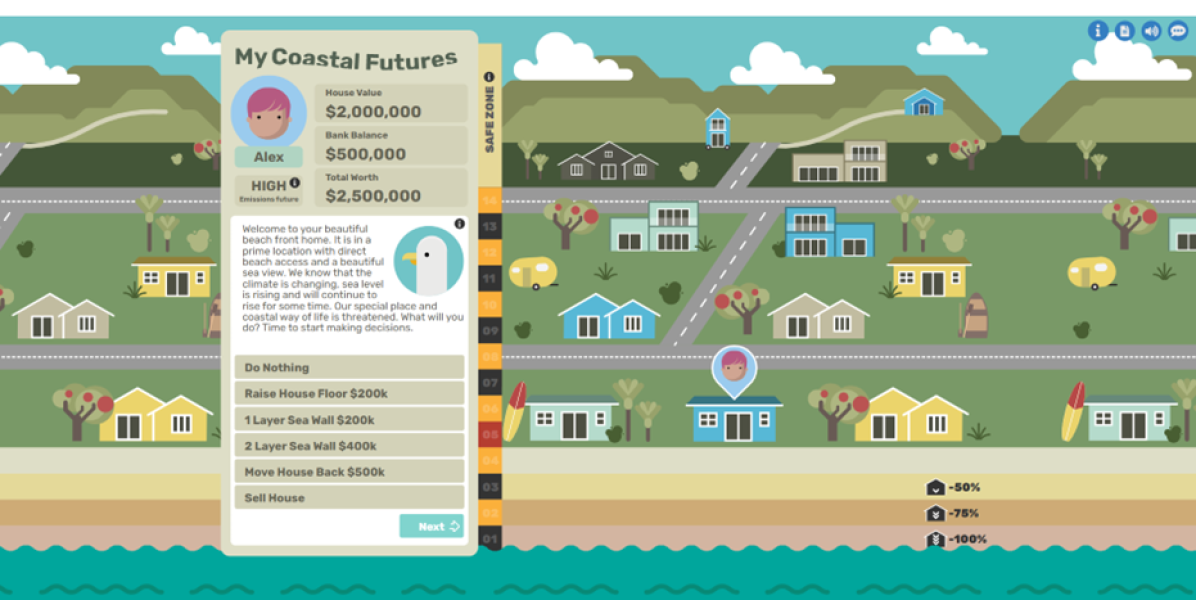Learning intention: Depending on the needs and location of your school, students apply their understanding of climate change and its potential impacts using the My Coastal Future ‘serious game’.
Using critical thinking skills, teamwork and compromise to get the best outcome, the game will introduce students to community-level decision-making and adaptation.
In this lesson, you will play NIWA’s online serious game, My coastal futures.
Playing the game
- Brief explanation of the lesson and what the game entails.
- Split class into groups of 4 with one device per group – chromebook, laptop, iPad etc.
- Play game a couple of times (if time allows).
- Students will need to apply skills like teamwork and compromise to try and get the best outcome.
My coastal futures serious game debrief
- Spend first 5 minutes in groups talking about what went well/was difficult for their group.
- Report back to class and have a class discussion comparing ideas.
- Talk about how and why adaptation to climate change is important.
| Seawall | Redesign | Relocate | |
|---|---|---|---|
| Description | An engineered wall to contain the ocean. Seawalls protect many New Zealand coastal towns and cities from seawater encroachment because of sea level rise, storm surges and waves at high tide. | Adapting existing assets for hazards e.g., raising floor levels to reduce flooding. | Moving away from a hazard source permanently e.g., move buildings/infrastructure, sell, and move to area with less hazards. |
| Advantages | Seawalls stop erosion of the land immediately behind the beach. They protect all properties, business, and infrastructure (roads etc.) behind the wall. | Retrofitting (adding or changing something after it is first built) is often less expensive than replacing. Less disruption than relocating. | Relocating people, buildings, infrastructure such as roads or water pipes and other assets away from the coast, further inland and/or to higher elevations means they are no longer impacted by sea-level rise and coastal erosion. Relocation of communities also provides opportunities to improve how a town functions e.g., adding new parks and playgrounds or creating new town centres with additional facilities that are easier to walk around. |
| Disadvantages | Sea walls impact the width and appearance of the beach. Beach use is lost in favour of protecting homes, businesses, community assets and infrastructure (roads, drains etc). There remains a risk of major storms overtopping the wall and flooding the area behind it. Repairs after storms and on-going maintenance will be required. | Cost to implement | Relocation is usually disruptive because it involves re-organising the community and moving homes, business, roads, community assets and infra-structure. Relocation costs can be very high. People may have cultural connections to a place (e.g., waahi tapu) which may make relocation very distressing. |
| Limits | Seawalls can fail causing flooding and erosion issues behind the wall. As the sea level rises further over time the risk of the seawall being overtopped will increase. | Redesign options are often not permanent solutions. | None. Well-planned relocation is a permanent/long term solution to the hazards of climate change. |
Climate tips for climate solvers - seawalls video
Watch this video to end the lesson - it provides an accessible 4-minute summary of pros and cons of seawalls.
Extra information for teachers: Why play serious games?

